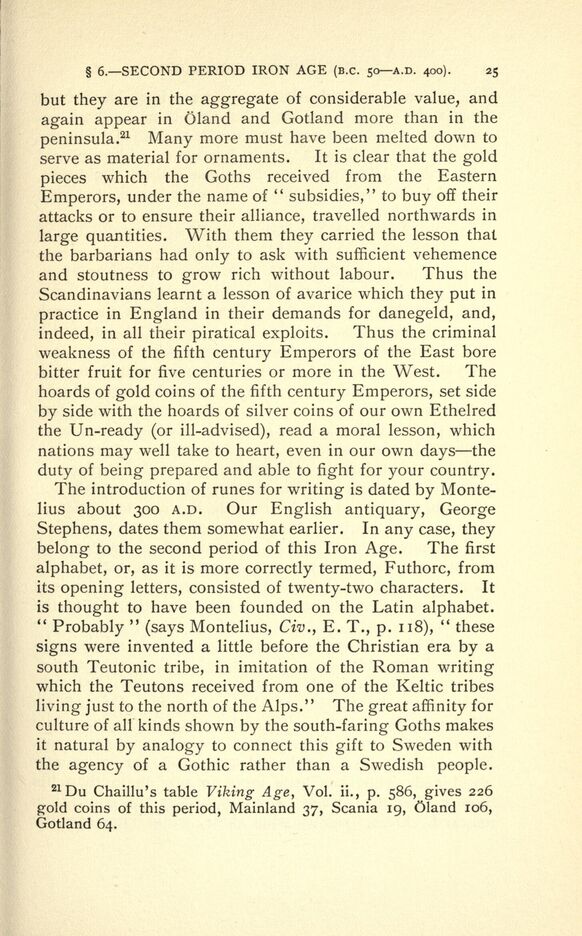
Full resolution (JPEG) - On this page / på denna sida - I. Introductory Lecture.—The Country and its Inhabitants in the Heathen Period up to 1000 A.D. - § 6. Second Period of the Iron Age

<< prev. page << föreg. sida << >> nästa sida >> next page >>
Below is the raw OCR text
from the above scanned image.
Do you see an error? Proofread the page now!
Här nedan syns maskintolkade texten från faksimilbilden ovan.
Ser du något fel? Korrekturläs sidan nu!
This page has never been proofread. / Denna sida har aldrig korrekturlästs.
6. SECOND PERIOD IRON AGE (B.C. 50 A. D. 400). 25
but they are in the aggregate of considerable value, and
again appear in Oland and Gotland more than in the
peninsula.
21
Many more must have been melted down to
serve as material for ornaments. It is clear that the gold
pieces which the Goths received from the Eastern
Emperors, under the name of
"
subsidies," to buy off their
attacks or to ensure their alliance, travelled northwards in
large quantities. With them they carried the lesson that
the barbarians had only to ask with sufficient vehemence
and stoutness to grow rich without labour. Thus the
Scandinavians learnt a lesson of avarice which they put in
practice in England in their demands for danegeld, and,
indeed, in all their piratical exploits. Thus the criminal
weakness of the fifth century Emperors of the East bore
bitter fruit for five centuries or more in the West. The
hoards of gold coins of the fifth century Emperors, set side
by side with the hoards of silver coins of our own Ethelred
the Un-ready (or ill-advised), read a moral lesson, which
nations may well take to heart, even in our own days the
duty of being prepared and able to fight for your country.
The introduction of runes for writing is dated by Monte-
lius about 300 A.D. Our English antiquary, George
Stephens, dates them somewhat earlier. In any case, they
belong to the second period of this Iron Age. The first
alphabet, or, as it is more correctly termed, Futhorc, from
its opening letters, consisted of twenty-two characters. It
is thought to have been founded on the Latin alphabet.
"
Probably
"
(says Montelius, Civ., E. T., p. 118),
"
these
signs were invented a little before the Christian era by a
south Teutonic tribe, in imitation of the Roman writing
which the Teutons received from one of the Keltic tribes
living just to the north of the Alps."
The great affinity for
culture of all kinds shown by the south-faring Goths makes
it natural by analogy to connect this gift to Sweden with
the agency of a Gothic rather than a Swedish people.
21
Du Chaillu s table
Viking^ Age, Vol. ii., p. 586, gives 226
gold coins of this period, Mainland 37, Scania 19, Oland 106,
Gotland 64.
<< prev. page << föreg. sida << >> nästa sida >> next page >>